Table of Contents
Liver disease and itchy skin are problems often raised together, but which liver problems can cause itching? And where may it bother you the most? Let’s dive into this puzzling connection.
How to treat itching from liver disease? We will provide some effective strategies to help you tackle the root causes of this problem and manage the condition better.
Does liver disease cause itching? Possible Links
Roughly 4.5 million people in the United States (1.8%) have liver disease, according to the National Health Interview Survey in 2018 (1).
Long-term liver problems can cause itching, also known as pruritus. The itchiness does not depend on how long the disease has lasted, how serious it is, or even the level of your liver function tests (LFTs) (2).
Although liver disease can cause itching, not all itching is due to liver disease. Skin problems such as eczema, psoriasis, lichen planus, or even scabies can also cause itchiness of the skin (3). However, if the following signs show up with your itchiness, your liver may have problems:
- You have itchiness all over the body instead of limiting it to certain parts, such as the scalp or palms.
- Your skin turns yellow; this feature may not be easy to tell by yourself, but your friends who have not met for a long time may notice this change first.
- You feel tired easily.
- You have liver problems before, such as cirrhosis or hepatitis.
What does itching feel like?
Itching makes you want to scratch your skin, but it is not exactly the same as pain. Symptoms of this condition may include (4):
- Redness
- Bumps, spots, or blisters
- Rash or hives
- Dry, cracked skin
- Leathery or scaly skin
When your skin is acutely inflamed, it would appear red, swelling, and have little bumps or blisters. When the inflammation lasts longer than several weeks (chronic inflammation), your skin may become dry, cracked, leathery, or scaly. This is partly because of the damage to your skin when you scratch it.
If you have chronic inflammation on your skin, try your best not to scratch it, as it only makes the condition worse.
If you are an older adult and experience severe itching or pain without a clear cause, it could signal a serious condition. You should find your doctor if those conditions last over two weeks (5).
Types of liver disease making you itch
When you have chronic liver disease, you easily have itchy skin. In a study, more than half of the patients with chronic liver disease at a hospital experienced itching (6).
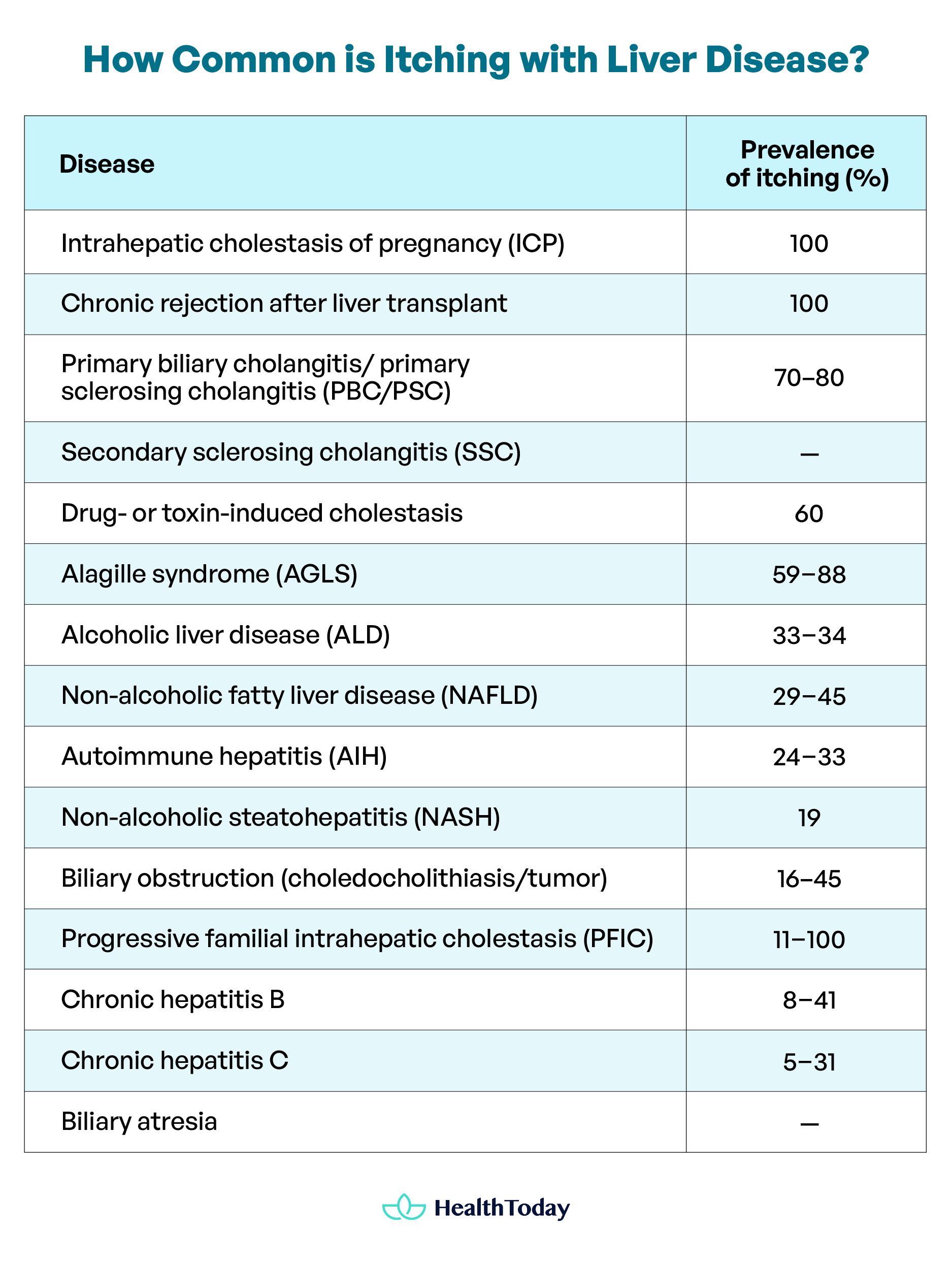
Itching is closely related to autoimmune liver diseases, and other conditions that affect the inside of the liver.
Here are liver diseases that can make you itch (7, 8, 9, 10, 11):
- Primary biliary cirrhosis (PBC)
- Primary sclerosing cholangitis (PSC)
- Intrahepatic cholestasis of pregnancy (ICP)
- Alagille syndrome (AGLS)
- Hereditary cholestatic syndromes, such as Wilson disease, hemochromatosis, and alpha-1 antitrypsin deficiency
- Drug- or toxin-induced cholestasis
- Progressive familial intrahepatic cholestasis (PFIC)
- Secondary sclerosing cholangitis (SSC)
- Fatty liver disease
- Hepatitis (liver inflammation), like autoimmune hepatitis (AIH), non-alcoholic steatohepatitis (NASH), and hepatitis A, B, and C
- Pancreatic cancer that blocks the bile outflow
- Bile-related diseases
Self-diagnosis is not recommended. If you notice any problems, it’s best to see your doctor (10).
Possible conditions linked to itching
The exact reasons for the link between liver disease and skin itching have not been fully understood (8, 12). Here are some intriguing theories:
Bile salts and itching
Studies suggest that serum bile acids are the primary cause of itching, which even makes healthy people itch when injected (7, 12).
Pruritus is a common symptom of cholestasis (also called ‘cholestatic pruritus’) when bile does not flow normally. The name ‘cholestasis’ comes from Greek words for ‘bile’ (chole) and ‘standing still’ (stasis).
A study also revealed that pruritus occurs in 80−100% of patients with cholestatic jaundice (7, 13). Jaundice is the name describing the condition when your skin turns yellow due to bile salt building up in your body.
The substance triggering pruritus (pruritogen) is thought to be produced in the liver and released as bile salts (made from bile acids). When bile flow decreases or is blocked, the pruritogens may build up under your skin and trigger itchiness (8, 14, 15).
Research also suggests that high bilirubin levels, a bile pigment, can stimulate itch-sensing nerves (16). In chronic liver disease, your liver can not break down bilirubin, causing itching as the result of the buildup of bile salts (17, 18).
The amount of blood bilirubin does not always match the severity. For example, you can have normal bilirubin levels but still have severe itching (12). In people with liver failure, bile acid levels tend to get very high, but the itching stops, suggesting that this theory may not fully explain the itchiness of the skin (14).
Does cirrhosis cause itching?
Cirrhosis is a late (severe) stage of scarring (fibrosis) of your liver caused by many forms of liver conditions, such as hepatitis and chronic alcoholism (18, 19). In other words, the hurt liver may lead to scar tissue, which stops the liver from working normally (20).
Many people don’t even know they have cirrhosis since they may not have any signs until their liver is severely damaged. Itching is a common symptom in cirrhosis, yet not necessarily a severe signal (11).
Primary biliary cirrhosis (PBC), an autoimmune disease that targets and damages the bile ducts, has long been linked with itching (8). Patients with PBC may have high levels of the fat lysophosphatidylcholine (LPC, which makes LPA) in their blood (21).
Scientists found that when they injected LPC into mouse skin, it activated a protein in keratinocytes (a type of skin cell), leading to dry skin and itchy skin nerves (12, 21, 22).
Other pruritogens
Besides bile salts, many natural substances in your body can be related to itching and liver disease (23, 24):
- Histamine: Studies have shown that people with cholestatic pruritus have high histamine levels in their blood. Unfortunately, taking antihistamines is often not effective for treating itching in this condition (12, 8).
- Endogenous opioids: The itchy effects of opioids depend on their receptor. When opioids activate μ-opioid receptors, they can cause itching. Conversely, κ-opioid receptors can stop itching. In cholestasis, too many μ-opioid receptors may be activated (7, 14).
- Substance P: It is a chemical that excites nerves and can cause itching. Sometimes, high levels of substance P are found in those with liver disease and skin itching (12, 15).
- Lysophosphatidic acid (LPA): LPA is a type of fat and a strong neuron activator (8). If you have cholestasis, your body may make excess LPA owing to the activation of autotaxin, an enzyme for LPA production. This LPA may make you release more substance P from nerve endings (12, 15).
- Alkaline phosphatase (ALP): ALP is an enzyme in the blood that breaks down proteins. Some studies suggest that those with liver disease and skin itching may have more ALP (15).
- Serotonin: Serotonin, despite being the well-known ‘feel-good’ hormone, can cause itch when it is secreted by the nerve endings of our skin by altering how we sense itching (8, 12). In this case, they are an inflammation signal instead of ‘feeling good.’
- Female hormones: Pregnant women, especially during the late second trimester, sometimes have cholestatic pruritus despite being healthy previously, which is called intrahepatic cholestasis of pregnancy (ICP).
Progesterone and estrogen metabolites change during pregnancy (which is highest during the late second trimester), or menstruation may worsen the itches in cholestasis. It is believed that these changes cause decreased bile transportation and a buildup of bile in pregnant women (25). Fortunately, cholestatic pruritus during pregnancy usually disappears on its own after the baby arrives (8, 12).
Where do you itch with liver problems?
Pruritus can be localized or generalized and either acute or chronic. Chronic pruritus means the itch has been around for over six weeks (8).
This can make it hard to sleep or even induce thoughts of suicide in severe cases when nothing can help the itch (14, 15).
Where does this occur?
The exact location and severity of itching can vary from person to person.
Itching caused by liver disease often first affects the palms of your hands and soles of your feet but can be more widespread and affects your whole body (2, 8). The discomfort usually worsens in the evenings and at night (26).
Itching is not exclusive to liver problems and can imply many different causes.
Other possible causes of itching
If you experience symptoms such as a rash or swelling, along with itchy skin, it’s important to identify what causes it. Here are some possibilities:
- Dry skin, especially in older people, during the winter and in dry weather (5).
- Skin reactions to hot temperatures or something you are allergic to. Common conditions are allergies, contact dermatitis, hives, heat rash (prickly heat), and sunburn (10, 27).
- Parasites such as pinworms, scabies, threadworms, insect bites, head lice, and body lice (28).
- Skin infections due to chickenpox, thrush, ringworm, or athlete’s foot (10).
- Chronic skin conditions include dandruff, eczema, psoriasis, lichen planus, folliculitis, and prurigo (10, 27).
- Hormonal changes, for example, during pregnancy (especially during the late second trimester, or around five to six months through the pregnancy), aging, and around menopause. Itching during pregnancy is not a concern, but it’s necessary to check with your doctor (5, 10, 29).
- Diseases that can affect your nervous system, such as anemia, diabetes, HIV/AIDS, and shingles (5, 28).
- Certain medications, including aspirin, opioids, some high blood pressure drugs, or the side effects of cancer treatments (29).
- Itching may mean your gallbladder, thyroid, or kidneys might not work well, but this is less common (10, 27).
- In rare cases, the reason may be due to some types of cancer (such as liver, pancreatic, leukemia, Hodgkin’s lymphoma) (5, 27). Sudden pruritus when touching hot water, when taking a bath or sauna may suggest a rare type of blood cancer called Polycythemia vera (30).
If you are concerned, it is best to see a doctor. The itchiness is unlikely to vanish on its own and can get worse over time. It will affect your sleep, mood, and overall well-being (8, 10).
How to treat itching from liver disease
Treating the underlying liver condition is the primary goal to relieve itching.
A hepatologist (a liver specialist) will guide you on how to manage your itching condition caused by liver diseases. However, it might take trial and error, experimenting with therapies, and adjusting the plan to find what works best for you.
Understanding the symptoms
Liver disease may not have symptoms in the early stages. If you experience any of the following symptoms along with itching, consult with a doctor (11, 19):
- The whites of the eyes (the sclera) turn yellow is a sign of jaundice
- Muscle cramps, fatigue, and weakness
- A loss of appetite that could lead to weight loss
- Mild pain or discomfort in the upper right side of the abdomen, over the liver
- Loss of sex drive (libido)
- Nausea or vomiting
Lifestyle changes
A healthy lifestyle can improve some liver problems (19), including getting enough sleep, not staying up late, and exercising regularly.
You might need to cut down your salt intake and have to get rid of alcohol (31).
If your liver disease causes bile flow problems (cholestasis), try to eat less fat, less processed meat, less fried potatoes, fish, margarine, and coffee. Instead, you should drink more water and eat more fruits and vegetables, which could help ease the bile overload (32).
Cirrhosis alters nutrient storage and energy utilization in the body, so people with this condition should avoid prolonged fasting (31):
- Eat smaller, more frequent meals.
- Have snacks every three to four hours
- Having a snack before bedtime or right after waking up
- Avoid raw or undercooked shellfish, fish, meat, unpasteurized milk, and dairy products. These foods can hide bacteria or viruses that can cause serious infections in people with cirrhosis.
Medications and therapy
Some types of liver diseases might need medication to get the boot.
You should strictly follow the doctor’s instructions for the right dose. Don’t buy drugs without knowing what it is for, especially an unknown oral remedy. If you are taking over-the-counter drugs, read the instructions carefully.
Drugs that could help with the itch are:
- Ursodeoxycholic acid (UDCA): Has little effect on itching in PBC. UDCA is also highly effective for treating itching in ICP. Plus, it is pregnancy-friendly (7, 13, 33).
- Bile acid-binding resins like cholestyramine (colestyramine): Can bind to bile salts and help remove them from the body, thus reducing itching (2, 13). It is often prescribed for cholestatic liver conditions (7).
- Fifampicin: An antibiotic, may be prescribed to manage the pruritogens and bring down LPA in some cases. Yet, it should be used under medical supervision (7, 13, 24).
- Fibrates (like bezafibrate): Can help reduce inflammation and fibrosis. They are believed to slow the progression of PBC and can work well with other treatments. Fibrates may be a safer option compared to rifampicin (7).
- Opioid inhibitors, such as naloxone, fenofibrate, and naltrexone: Can block the itch signal (by blocking the opioid effects) in the brain (13).
- Serotonin receptor antagonists (SSRIs) like sertraline (Zoloft) or fluoxetine (Prozac) or tricyclic antidepressants like doxepin: May relieve pruritus in some cases. Sertraline has also been shown to reduce scratching on the skin (15).
- IBATi: Recent clinical trials suggest that IBATi may be a promising treatment option for cholestatic pruritus, which helps you get rid of bile salts (14). However, these drugs are expensive (7, 17).
- Cannabinoids like dronabinol: Have been shown to help relieve severe itching. However, it only had a small and short-term effect (15, 17).
- Over-the-counter or prescription antihistamines like Zyrtec or Benadryl: Can help block histamine and are the most common drugs to treat itchiness due to skin irritation, allergy, or inflammation like eczema (2, 34). However, if the itchiness is due to liver disease (35), antihistamines may not be helpful. Keep in mind that some antihistamines may cause danger if you drive. Read the warning labels carefully.
- Maralixibat: A new treatment for itchy skin in people with Alagille syndrome by stopping bile from being reabsorbed by the body. Maralixibat is currently the only treatment approved by the FDA for specifically tackling itching caused by cholestasis in Alagille syndrome (12).
Note that some of these drugs may pose some adverse effects, including loss of appetite, constipation, diarrhea, abdominal discomfort, bloating, and even liver and kidney damage (2, 8). Read the warning labels carefully before trying any medications on your own.
Doctors may suggest you start with moisturizers or cooling ointments, which will solve most of the pruritus. If this does not help, they will change to drugs like cholestyramine, rifampicin, and naloxone. If this still does not help, more experimental treatments such as thalidomide, ondansetron, and phenobarbitals may be used (36).
Those with severe cholestatic pruritus caused by cholestatic liver disease may not find relief from medication alone. In this case, doctors may recommend these treatments (7, 13, 17, 24):
- Ultraviolet B phototherapy or bright-light therapy: Using certain types of light to help the skin heal. This is an effective treatment for people with itchiness due to psoriasis and has been tried on cholestatic pruritus with some positive results.
- Endoscopic nasobiliary drainage: Doctors can drain fluids from your liver through your nose with a thin tube with a camera.
- Albumin dialysis: Using the molecular adsorbent recirculating system.
- Plasmapheresis: It is like a “blood detox,” in which blood is taken out of the body, filtered, and sent back in. This can also be used for pregnant women.
- Charcoal hemoperfusion: System for filtering blood
However, these treatments are only available in a few medical centers, and it can be hard to know how to get referred to them (13).
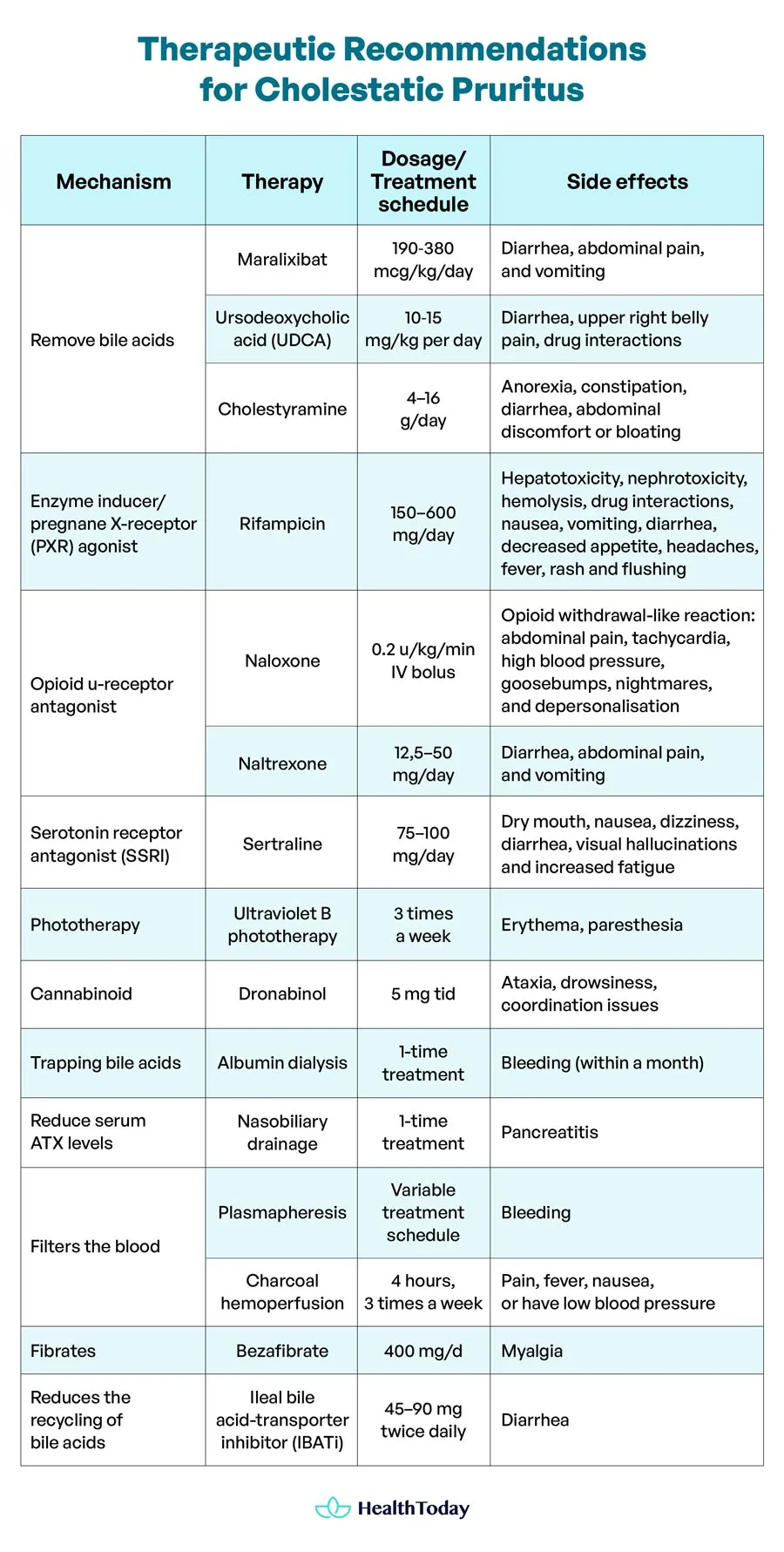
Home remedies
For an itching-defense strategy, you should avoid scratching and any irritants (10, 14, 28):
- Keep your nails clean, short, and smooth. You can wear gloves while sleeping.
- Instead of scratching your skin, try patting or tapping when the itch hits.
- Be picky with your skin products—ditch harsh soaps, deodorants, and scented products. They can further irritate your skin.
- If you need laundry detergent, go for the sensitive skin option.
- Avoid wearing tight clothes or clothes made from wool or synthetic fabrics. Opt for light, comfy, loose clothing made of cotton or silk.
- Try to limit time spent in hot environments and the sun. In the dry winter months, bring in the humidifier.
Another important tip is to keep your skin hydrated. Here are some suggestions (5, 10, 13):
- Hold something cool, like a damp towel, against your skin.
- Try skincare products with “hypoallergenic” on the label, which are less likely to cause allergic reactions.
- Choose the most “greasy” moisturizers (emollients). Ointments or oils are best, followed by creams and lotions. Apply them three to four times a day.
- The best time to apply moisturizers is right after washing your hands or taking a bath. If your hands are dry, put petroleum jelly (such as Vaseline) on them before bed.
- To relieve mild and localized itch, try a cream with 1‒2% menthol and aqueous cream, which helps to cool down the itch.
- Other over-the-counter ointments, like corticosteroids and calcineurin inhibitors, can also help alleviate itching.
Taking cool or lukewarm baths or showers can also help soothe itchy skin. Oatmeal baths and bath oils can also make your skin less dry. Avoid hot water, and limit your time in the bathtub (5, 10, 28).To reduce swelling or pain, grab a cold compress from the store or make one at home (5). Grapefruit juice may help relieve cholestasis itching. However, studies have not shown a consistent result (15).
What are the 4 warning signs of a damaged liver?
Liver disease can progress silently without noticeable symptoms in its early stages. However, there are some signs that you shouldn’t ignore: feeling tired easily, yellowing of your eyes or skin (jaundice), a bloated belly and easy fullness after meals(ascites), a low libido, and a loss of appetite (19, 37). They may indicate a chronic liver problem.
Does a fatty liver cause itching?
Fatty liver can cause itching, yet it is less common than other liver diseases, like cirrhosis and cholestasis (2, 7). The itching might come from the increased bile, a response aimed at detoxifying and managing excess cholesterol (8, 38). This itch can be distracting and make you want to scratch your skin.
How do I know my liver is failing?
Liver failure happens when your liver is severely damaged and stops functioning (20). As your liver gets worse, you will feel tired easily. Other noticeable symptoms are easy bruising and bleeding, jaundice, darker urine color, swelling, brain fog, confusion, or sleep troubles (11).
If you suspect liver failure or notice those signs, seek immediate medical attention.
Why am I itching all over my body with no rash?
Itching (pruritus) all over the body without rash can have numerous underlying causes. Some potential causes are pregnancy-related obstetric cholestasis, menstruation, or just when wearing wool or your skin is dehydrated (27).
Additionally, people with cholestatic pruritus don’t develop the typical skin changes—no redness, hives, or swelling (2).
When should I be worried about itching?
Itchy skin can occur during any stage of liver disease. This symptom doesn’t hint at how serious the liver disease is, how fast it is getting worse, or your prognosis (2, 11).
If itching lasts over two weeks and doesn’t improve with over-the-counter treatments, consult a doctor (5). You should be more careful if you have an underlying condition and accompanying symptoms or are pregnant (19).
Summary
Various factors, including some liver disease, can cause pruritus or itching. Cirrhosis and cholestasis are common causes that are tough to address.
Liver disease and skin itching often target the palms of the hands and soles of the feet. However, they can be widespread, affecting the entire body.
Although experts have several theories about why itching occurs with liver disease, it doesn’t signify a worsening condition.
You should discuss the symptoms with your doctor, especially if the itching persists for more than two weeks. They might refer you to a hepatologist for a personalized guide on how to treat itching from liver disease.





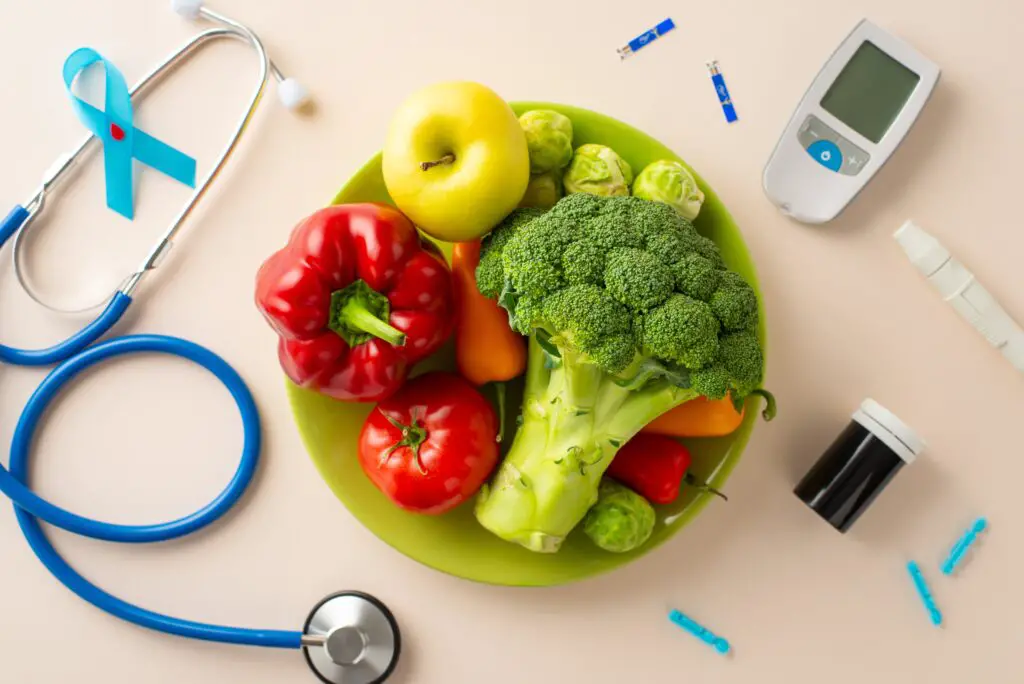



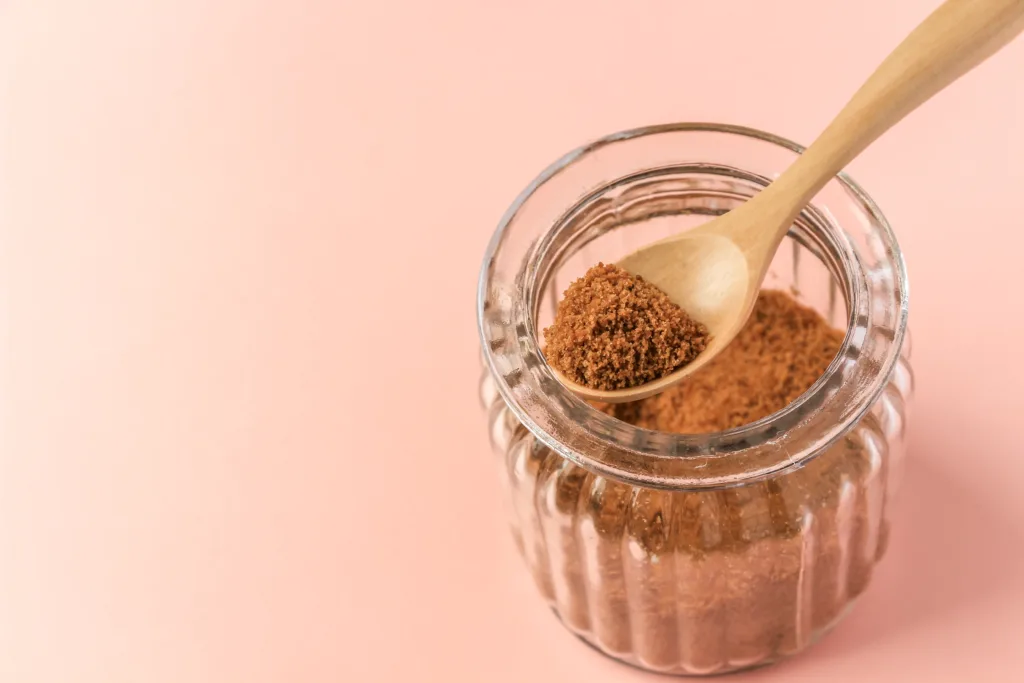
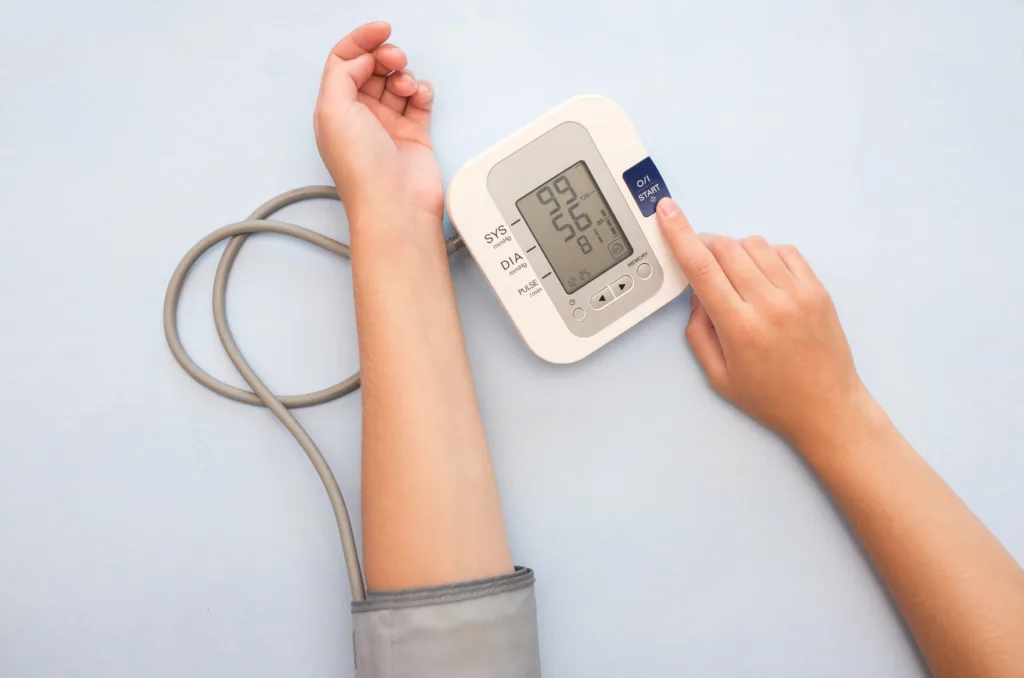

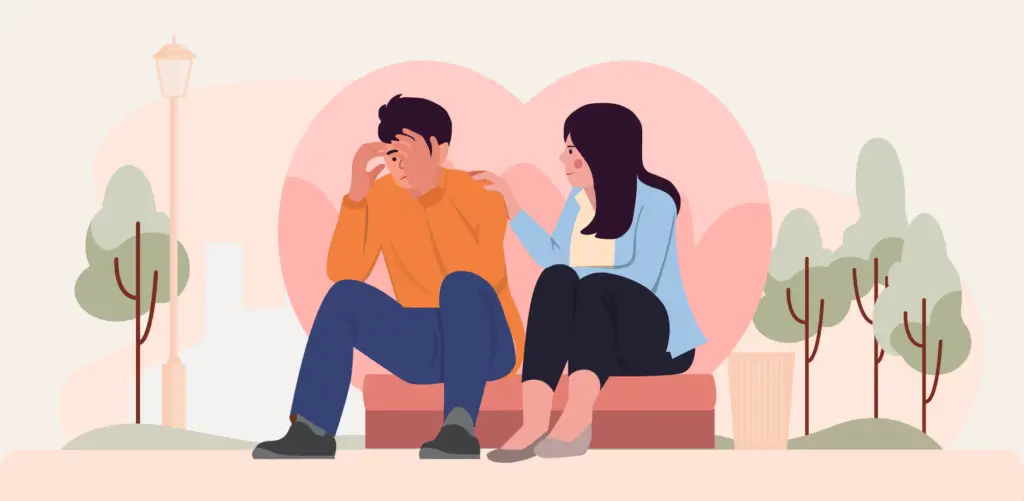
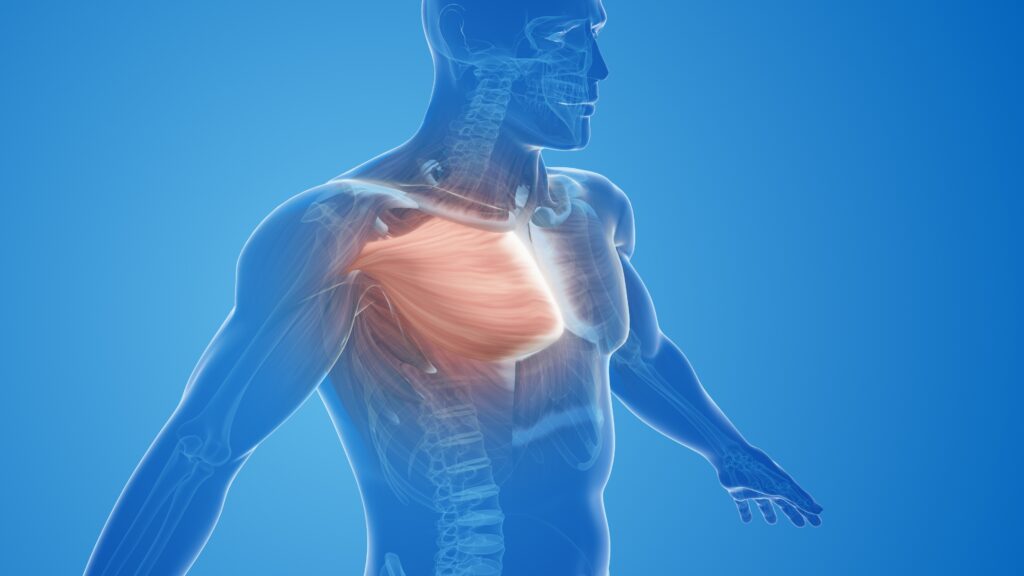

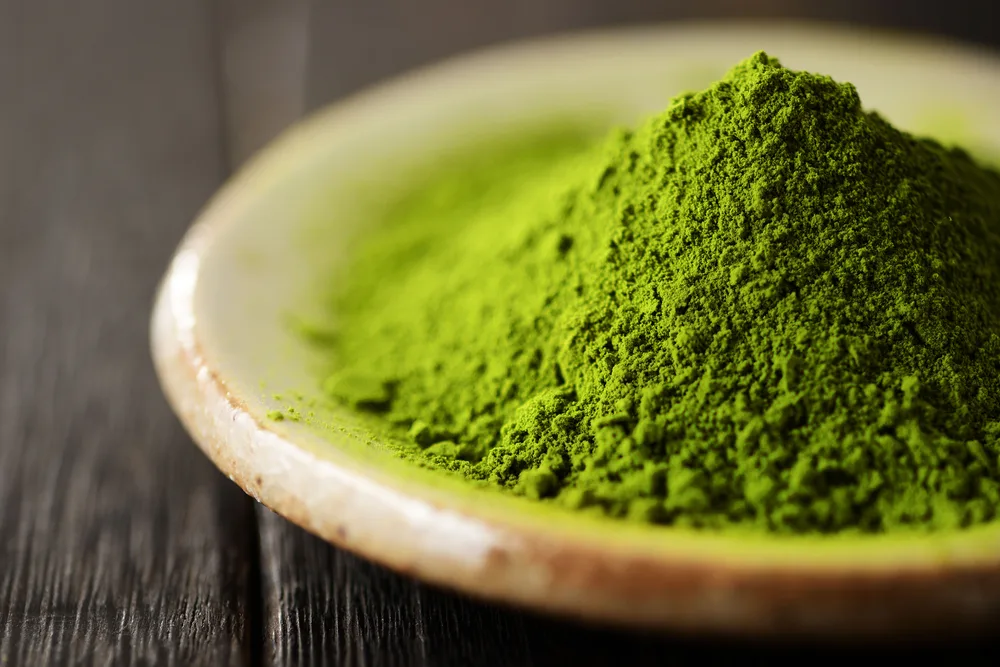

Comments
0